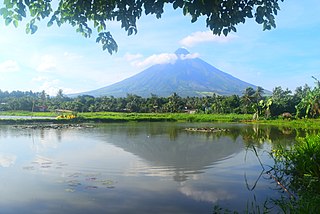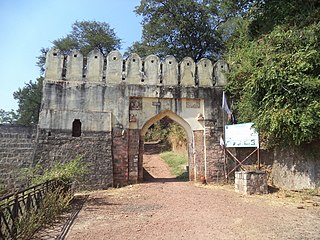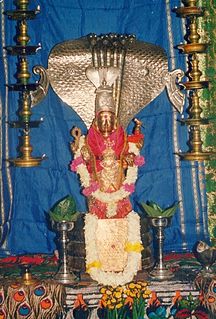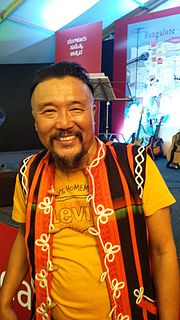Naga or NAGA may refer to:

Bicol, known formally as the Bicol Region or colloquially as Bicolandia, is an administrative region of the Philippines, designated as Region V. Bicol comprises six provinces, four on the Bicol Peninsula mainland – Albay, Camarines Norte, Camarines Sur, and Sorsogon – and the offshore island provinces of Catanduanes and Masbate.

Nagaland is a state in northeastern India. It is bordered by the state of Arunachal Pradesh to the north, Assam to the west, Manipur to the south and the Sagaing Region of Myanmar to the east. Its capital city is Kohima and its largest city is Dimapur. It has an area of 16,579 square kilometres (6,401 sq mi) with a population of 1,980,602 per the 2011 Census of India, making it one of India's smallest states.

The Nāga or Nāgī is a divine or semi-divine race of half-human half-serpent beings that reside in the netherworld (Patala) and can occasionally take human form. Rituals devoted to these supernatural beings have been taking place throughout south Asia for at least two thousand years. They are principally depicted in three forms: wholly human with snakes on the heads and necks, common serpents, or as half-human half-snake beings in Hinduism, Buddhism and Jainism.
Nagas are various ethnic groups native to northeastern India and northwestern Myanmar. The groups have similar cultures and traditions, and form the majority of population in the Indian state of Nagaland and Naga Self-Administered Zone of Myanmar; with significant populations in Manipur, and Assam in India; Sagaing Region and Kachin State in Myanmar (Burma).

Naga, officially the City of Naga or the Pilgrim City of Naga, is a 1st class independent component city in the Bicol Region of the Philippines. According to the 2020 census, it has a population of 209,170 people.

Sultan Naga Dimaporo, officially the Municipality of Sultan Naga Dimaporo, is a 5th class municipality in the province of Lanao del Norte, Philippines. According to the 2020 census, it has a population of 60,904 people.

Japanese dragons are diverse legendary creatures in Japanese mythology and folklore. Japanese dragon myths amalgamate native legends with imported stories about dragons from China, Korea and the Indian subcontinent. The style of the dragon was heavily influenced by the Chinese dragon. Like these other East Asian dragons, most Japanese ones are water deities associated with rainfall and bodies of water, and are typically depicted as large, wingless, serpentine creatures with clawed feet. The modern Japanese language has numerous "dragon" words, including indigenous Tatsu from Old Japanese ta-tu, Sino-Japanese ryū or ryō竜 from Chinese lóng龍, nāga ナーガ from Sanskrit nāga, and doragon ドラゴン from English "dragon".
In Pahang Malay folklore, the Seri Gumum Dragon is a legendary giant serpent locally called Nāga and commonly described as taking the form of an Asian dragon, that inhabit the Chini Lake in Pahang, Malaysia. There have been a variety of legends associated with the creature in the oral literature. The notable one is related to the origin myth of the lake itself, while another legend narrates about a love story between female Seri Gumum and a male Nāga called Seri Kemboja that leads to the origin myth of Tioman and Lingga Islands.

Manikgad / is an ancient fort in Chandrapur district, Maharashtra. It is a hill fort 507 metres above sea level built by the Naga kings in 9 CE. The fort is in ruins and is frequented by wild animals that live in the vicinity, such as panthers and boars. Several monuments of historical importance are nearby.

Nainativu, is a small but notable island off the coast of Jaffna Peninsula in the Northern Province, Sri Lanka. The name of the island alludes to the folklore inhabitants, the Naga people. It is home to the Hindu shrine of Nagapooshani Amman Temple; one of the prominent 64 Shakti Peethas, and the Buddhist shrine Nagadeepa Purana Viharaya.

The Naga people were believed to be an ancient tribe who once inhabited Sri Lanka and various parts of Southern India. There are references to them in several ancient texts such as Mahavamsa, Manimekalai and also in other Sanskrit and Pali literature. They are generally being represented as a class of superhumans taking the form of serpents who inhabit a subterranean world.
The Ao or Central Naga languages are a small family of Sino-Tibetan languages spoken by various Naga peoples of Nagaland in northeast India. Conventionally classified as "Naga", they are not clearly related to other Naga languages, and are conservatively classified as an independent branch of Sino-Tibetan, pending further research. There are around 607,000 speakers of the languages in total.

Akkineni Naga Chaitanya is an Indian actor who works in Telugu cinema. Chaitanya made his debut with Josh (2009), and his breakthrough came with Gautham Vasudev Menon-directed Ye Maaya Chesave (2010). For his performances in various films, Chaitanya won several awards including Filmfare Award South for Best Debut, Nandi Award for Best Supporting Actor and SIIMA Award for Best Actor (Critics).

Jesse Manalastas Robredo was a Filipino politician who served as Secretary of the Interior and Local Government in the administration of President Benigno Aquino III from 2010 until his death in 2012. Robredo was a member of the Liberal Party.

Higashi-naga-iwa Glacier is a wide glacier flowing to the sea at the eastern side of Naga-iwa Rock in Queen Maud Land, Antarctica. It was mapped from surveys and air photos by the Japanese Antarctic Research Expedition, 1957–62, and, in association with nearby Naga-iwa Rock, named "Higashi-naga-iwa-hyoga".

Rewben Mashangva, also Guru Rewben Mashangva, is a folk musician and singer from Manipur, India. He is known for reviving musical tradition of the Tangkhul Naga of Manipur, and use of traditional musical instruments in his songs. Influenced by musicians such as Bob Dylan and Bob Marley, Rewben Mashangva has created many Naga tribal folk songs based on blues and ballad rhythms. He is known by different names including, 'Bob Dylan of the Nagas' and 'King of Naga folk blues', plus 'Father of Naga folk blues'. He received the National Tribal Award 2011-12, for his contribution to the development of tribal music from the Ministry of Tribal Affairs, Government of India. The Government of India honoured him in 2021, with the award of Padma Shri, the fourth highest Indian civilian award for his rich contribution to art.
Rhynchorhamphus arabicus or Arabian flyingfish is a halfbeak of the family Hemiramphidae of the order Beloniformes.
Rhynchorhamphus malabaricus or Malabar halfbeak is a halfbeak of the family Hemiramphidae of the order Beloniformes.

Naga Pelangi is a wooden junk rigged schooner of the Malay pinas type built using traditional lashed-lug techniques from 2004 to 2009 in Kuala Terengganu, Malaysia. Finished in 2010, it is operated as a charter vessel in South East Asia.













